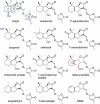Strigolactones as germination stimulants for root parasitic plants
- PMID: 20403809
- PMCID: PMC2900819
- DOI: 10.1093/pcp/pcq055
Strigolactones as germination stimulants for root parasitic plants
Abstract
Witchweeds (Striga spp.) and broomrapes (Orobanche and Phelipanche spp.) are the two most devastating root parasitic plants belonging to the family Orobanchaceae and are causing enormous crop losses throughout the world. Seeds of these root parasites will not germinate unless they are exposed to chemical stimuli, 'germination stimulants' produced by and released from plant roots. Most of the germination stimulants identified so far are strigolactones (SLs), which also function as host recognition signals for arbuscular mycorrhizal fungi and a novel class of plant hormones inhibiting shoot branching. In this review, we focus on SLs as germination stimulants for root parasitic plants. In addition, we discuss how quantitative and qualitative differences in SL exudation among sorghum cultivars influence their susceptibility to Striga.
Figures





Similar articles
-
The strigolactone story.Annu Rev Phytopathol. 2010;48:93-117. doi: 10.1146/annurev-phyto-073009-114453. Annu Rev Phytopathol. 2010. PMID: 20687831 Review.
-
The mechanism of host-induced germination in root parasitic plants.Plant Physiol. 2021 Apr 23;185(4):1353-1373. doi: 10.1093/plphys/kiab043. Plant Physiol. 2021. PMID: 33793958 Free PMC article. Review.
-
Role of Strigolactones in the Host Specificity of Broomrapes and Witchweeds.Plant Cell Physiol. 2023 Sep 15;64(9):936-954. doi: 10.1093/pcp/pcad058. Plant Cell Physiol. 2023. PMID: 37319019 Free PMC article. Review.
-
SeedQuant: a deep learning-based tool for assessing stimulant and inhibitor activity on root parasitic seeds.Plant Physiol. 2021 Jul 6;186(3):1632-1644. doi: 10.1093/plphys/kiab173. Plant Physiol. 2021. PMID: 33856485 Free PMC article.
-
Strigolactones and root infestation by plant-parasitic Striga, Orobanche and Phelipanche spp.Plant Sci. 2011 Mar;180(3):414-20. doi: 10.1016/j.plantsci.2010.11.007. Epub 2010 Nov 23. Plant Sci. 2011. PMID: 21421387 Review.
Cited by
-
A paradigm shift towards low-nitrifying production systems: the role of biological nitrification inhibition (BNI).Ann Bot. 2013 Jul;112(2):297-316. doi: 10.1093/aob/mcs230. Epub 2012 Oct 31. Ann Bot. 2013. PMID: 23118123 Free PMC article. Review.
-
Structural requirements of strigolactones for germination induction and inhibition of Striga gesnerioides seeds.Plant Cell Rep. 2013 Jun;32(6):829-38. doi: 10.1007/s00299-013-1429-y. Epub 2013 Apr 6. Plant Cell Rep. 2013. PMID: 23563521
-
Recent progress in the chemistry and biochemistry of strigolactones.J Pestic Sci. 2020 May 20;45(2):45-53. doi: 10.1584/jpestics.D19-084. J Pestic Sci. 2020. PMID: 32508512 Free PMC article.
-
Establishment of strigolactone-producing bacterium-yeast consortium.Sci Adv. 2021 Sep 17;7(38):eabh4048. doi: 10.1126/sciadv.abh4048. Epub 2021 Sep 17. Sci Adv. 2021. PMID: 34533983 Free PMC article.
-
Non-chemical Control of Root Parasitic Weeds with Biochar.Front Plant Sci. 2017 Jun 7;8:939. doi: 10.3389/fpls.2017.00939. eCollection 2017. Front Plant Sci. 2017. PMID: 28638393 Free PMC article.
References
-
- Akiyama K., Matsuzaki K., Hayashi H. Plant sesquiterpenes induce hyphal branching in arbuscular mycorrhizal fungi. Nature. 2005;435:824–827. - PubMed
-
- Awad A.A., Sato D., Kusumoto D., Kamioka H., Takeuchi Y., Yoneyama K. Characterization of strigolactones, germination stimulants for the root parasitic plants Striga and Orobanche, produced by maize, millet and sorghum. Plant Growth Regul. 2006;48:221–227.
-
- Bouwmeester H.J., Matusova R., Zhongkui S., Beale M.H. Secondary metabolite signalling in host–parasitic plant interactions. Curr. Opin. Plant Biol. 2003;6:358–364. - PubMed
Publication types
MeSH terms
Substances
LinkOut - more resources
Full Text Sources
Other Literature Sources
Miscellaneous

